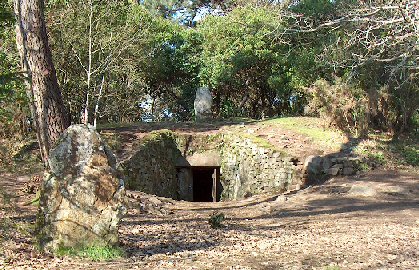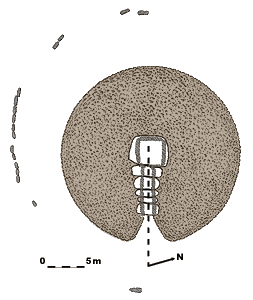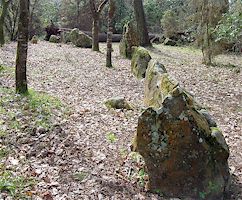|
Location:
Carnac, France. |
Grid Reference:
47� 35' 45.47" N, 3� 3' 13.57" W. |

 Kercado:
(Passage Mound).
Kercado:
(Passage Mound).
Kercado - 'Place of St. Cado'.
This tranquil, understated passage-mound (Often
referred to as a a
dolmen), sits in the Carnac woods on one of the highest point of land in the
surrounding area. Dated at around 4,800 BC, it is also one of the earliest
Megalithic structures in Europe.
The
Kercado
passage mound, south-east of the Kermario alignment produced
Radio-Carbon dates of 4,700 BC. The entrance of the chamber faces
32�
south of east, almost exactly towards midwinter sunrise.
(3)
| Kercado:
(Place of St. Cado). |
Location: Approximately 1-2 miles south of the
Kermario
alignments, which point towards it. (Use the water tower as a reference point). The site is
located in a private property but is open to the public..
The monument was excavated in 1863,
(1) by R. Galles,
and again in 1925, when it was studied and restored by Z. Le Rouzic who
remodelled the cairn and 'artificially raised the imposing
menhir that today sits on top of it'
(2). The cairn is 40m in
diameter with suggestions of a wall-face around it.
(2) The mound was previously
surrounded by a circle of small menhirs 4 metres out.
(13) The main
passage is 6.5 metres long and leads to a large chamber where artefacts were found
from a succession of occupants, which included axes, pearls, arrow
heads, and 147 variscite beads, were found lying next to ceramics dating
from the late Neolithic and the Bell Beaker period.
(2). It was constructed
around 4600 BC and used for approximately 3,000 years.
(13)

Plan of the Kercado passage-mound (2)
Inside, the passage tomb is a single, quadrangular chamber (2.2 x
3.2m). The walling consists of 17 contiguous slabs; the passage is
covered by five capstones and the chamber by a single one. Unusually
for a passage-mound, the capstones do not touch the upright slabs, due
to a layer of dry-stone walling between them.


Kerbstones (left), and Capstone with
axe-head engraving (right)
Two pillar stones of the passage, as well as the one marking the
southern entrance of the chamber, bear a reticulated motif similar
to that of Man�-Kerioned or Petit-Mont d'Arzon.The northern jamb of the passage opening into the chamber no longer
bears any sign of decoration but does take on the shape of an
anthropomorphic figure which was probably roughly hewn in the stone.
The ceiling of the chamber is adorned with a large "axe-plough" sign
similar to that of the Locmariaquer steles. The outline of the
capstone is unknown, but the unusual positioning of the sign
suggests that the stone was probably re-used at some point in time.
Two pillar stones of the passage, as well as the one marking the
southern entrance of the chamber, bear a reticulated motif similar
to that of Man�-Kerioned or Petit-Mont d'Arzon.
(Other Passage Mounds)
(Other French sites)
|



